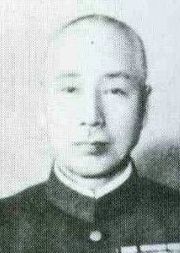- Nobuyoshi Mutō
-
Baron Mutō Nobuyoshi
Japanese General Baron Mutō NobuyoshiBorn July 15, 1868
Saga, Saga PrefectureDied July 27, 1933 (aged 65)
Shinkyo, ManchukuoAllegiance Empire of Japan Service/branch  Imperial Japanese Army
Imperial Japanese ArmyYears of service 1894 - 1933 Rank Field Marshal Unit 24th infantry regiment Commands held Kwangtung Army Battles/wars First Sino-Japanese War
Russo-Japanese War
Second Sino-Japanese WarAwards Order of the Golden Kite (1st class, 2nd class, 3rd class)
Order of the Rising Sun (1st class)In this Japanese name, the family name is "Mutō".Baron Nobuyoshi Mutō (武藤 信義 Mutō Nobuyoshi, 15 July 1868 – 27 July 1933) was Commander of the Kwangtung Army in 1933, Japanese ambassador to Manchukuo, and a field marshal in the Imperial Japanese Army.
Contents
Biography
Mutō was born in an ex-samurai family from Saga Domain. After graduating from the Imperial Japanese Army Academy, he served in the First Sino-Japanese War as a lieutenant in the infantry. After the war (and his promotion to captain) he was sent twice to Russia as a military attaché, spending time in Vladivostok and in Odessa. He was fluent in the Russian language, which proved invaluable during the Russo-Japanese War. After his promotion to major, then colonel, he returned to Japan in a posting with the Imperial Guards.[1]
From 1915-1916, Mutō was Chief of 2nd Section (Maneuvers), 1st Bureau, Imperial Japanese Army General Staff. From 1917, he was assigned to military intelligence and headed the Harbin Special Agency and operational offices in Irkutsk and Omsk. He returned to administrative positions in Japan from 1919–1921, before being appointed commander of the IJA 3rd Division in 1921 and being dispatched to Russia during the Siberian Expedition against the Bolshevik Red Army.
Mutō returned to Japan in 1922 as Vice Chief of the General Staff to 1925, and a member of the Supreme War Council from 1925-1926. He was briefly appointed commander of Tokyo Defense Command before assuming the role of Commander in Chief of the Kwangtung Army, from 28 July 1926 – 26 August 1927.
Mutō was active in the founding the new state of Manchukuo. After a stint as Inspector-General of Military Training (26 August 1927 – 26 May 1932), he then returned to Manchuria from 1932 to 1933 as Commander in Chief of the Manchukuo Imperial Army, while simultaneously holding the positions of Commander of the Kwantung Army and Governor of Kwantung Leased Territory. As Ambassador Extraordinary and Plenipotentiary to Emperor Hirohito, Mutō signed the Japan-Manchukuo Protocol of 1932. In 1933, he supervised Operation Nekka, the invasion of Jehol. In early 1933, he was promoted to field marshal.[2]
In the meatime the puppet state of Manchukuo, under the supervision of the controversial chief of the Japanese secret service Kenji Doihara, soon turned into a vast criminal enterprise where rape, sexual humiliation, child molestation, assault and murder became institutionalized means of terrorizing and controlling Manchuria's Chinese and Russian population. Robbery, arbitrary confiscation of property and unabashed extortion became commonplace. Brothels, opium dens, gambling houses and narcotics shops run by Japanese gendarmes competed with the state monopoly syndicate of opium.[3] Many conscientious Japanese officers protested these conditions, but Tokyo ignored them and consequently they fell silent. Mutō tried to restrain Doihara's activity, which he considered a disgrace for Imperial Japan, but in vain. He protested, but he was ignored. He either died of illness or committed ritual suicide allegedly having left a note to the Emperor Hirohito pleading for mercy for the people of Manchuria[4][5] (see also Kanji Ishiwara).
His elevation to the title of danshaku (baron) was posthumous, as were his awards of the Order of the Golden Kite (1st class) and Order of the Rising Sun (1st class). His grave is at the Buddhist temple of Gokoku-ji in Tokyo, and the sword he received on his promotion to gensui is on display at the Yūshūkan Museum at Yasukuni Shrine in Tokyo.
References
Books
- Bix, Herbert B (2001). Hirohito and the Making of Modern Japan. Harper Perennial. ISBN 0-06-093130-2.
- Coox, Alvin (1990). Nomonhan: Japan Against Russia, 1939. Stanford University Press. ISBN 0804718350.
- Dupuy, Trevor N. (1992). Encyclopedia of Military Biography. I B Tauris & Co Ltd. ISBN 1-85043-569-3.
External links
- Ammenthorp, Steen. "Muto Nobuyoshi". The Generals of World War II. http://www.generals.dk/general/Muto/Nobuyoshi_Baron/Japan.html.
- Muto's Field Marshal Sword at Yasukuni Museum, Tokyo
Notes
- ^ Dupuy, Encyclopedia of Military Biography
- ^ Ammenthorp, the Generals of World War II
- ^ White Terror: Cossack Warlords of the Trans-Siberian,p.299, Jamie Bisher, Routledge, ISBN 978-0714656908, 2005
- ^ White Terror: Cossack Warlords of the Trans-Siberian,p.299, Jamie Bisher, Routledge, ISBN 978-0714656908, 2005
- ^ Japan's Imperial Conspiracy, p. 561, David Bergamini, Morrow, 1971 ISBN 978-0688019051
Government offices Preceded by
Mannosuke YamaokaGovernor-General of Kwantung Leased Territory
1932-1933Succeeded by
Takashi HishikariCategories:- 1868 births
- 1933 deaths
- Marshals of Japan
- People from Saga (city)
- Kazoku
- Japanese military personnel of the Russo-Japanese War
- Japanese generals
- Recipients of the Order of the Rising Sun
- Recipients of the Order of the Golden Kite
Wikimedia Foundation. 2010.

